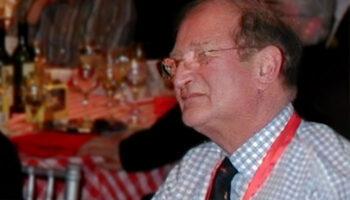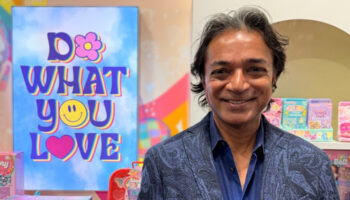Bluebird Toys founder, Sir Torquil Norman, CBE, discusses his extraordinary career

As Sir Torquil Norman, CBE, celebrates his 90th birthday, we look back at a roundtable chat from 2014 where he tells Dougal Grimes how Polly Pocket came to market…
Sir Torquil Norman, you’re the founder of Bluebird Toys and the inventor of an all-time classic… The Big Yellow Teapot. I wanted to ask: how did you get started in toys?
Well. I’ve had a slightly checkered career… I wound up as a banker for a short period and decided that that wasn’t something for me. I’d teamed up with a friend and we started a business whose job it was to lend money to small companies who couldn’t otherwise get it from the banks and so on. That’s a whole industry now, but in those days it was more difficult.
Anyway, one of the companies I got involved in was called Berwick’s Toy Company in Liverpool. Ken Berwick had a very good position making the cheapest games and playsuits and so on… We made a little game with a straw and a little football that I think retailed for 1.11. That gives you an idea! We built that business, one way and another, into a group called Berwick Timpo. Bluebird Toys came later and made Polly Pocket, for example, and various other things that were certainly pure inventions.
Fantastic. I’m always very interested in the creative side… With something like Polly Pocket, can you tell us where that idea came from; how it sparked?
I can tell you exactly, yes. We used to work with an engineering toy developer called Origin. You probably know Chris Wiggs, Chris Taylor, and so on… They used to present us with toys of all sorts. One day I went in to see Chris Wiggs and he said, “I want to show you something I made for my daughter six years ago. I never thought it was commercial, but she enjoyed it…” He produced a wooden box with a little wooden doll in it – solid wood – and asked what I thought of it. For want of something to say more than anything else I said, “Can you make the doll move? Bend the waist and head, and so on?” He said, “No, it’s too small; it wouldn’t be possible…”

Okay…
But I said, “Well, come on: you’re a good engineer. I’d like to see one, so I’ll come back in a couple of weeks.” And that was really the start of Polly Pocket. It was one of those products which was so easy to develop once the original idea had taken hold. We made little rings and little compacts and so on. We dealt with Mattel in all sorts of other areas. I thought, “What the hell? I may as well go and show it to them.” Normally, getting to see a buyer is difficult enough, but rather unusually I got Jill Barad, who was the chief executive, Lindsey Williams who’d looked after the world markets, and John Ammerman, and I said, “I’d like to see everybody, please, for half an hour in your presentation room.”
I showed them the first year’s range of Polly Pocket, which was mostly little compacts and little rings you could put on your finger. These guys were sitting up in a dais a bit higher, and I was sitting a bit lower. I set out the entire Polly Pocket range underneath my pocket-handkerchief. They said, “Torquil, we’ll do this as a friend, but aren’t you wasting our time?” I said, “Well, I don’t think so…”
Then I lifted up the corner of the handkerchief and took out this little tiny figure, which in those days was about an inch high, and said, “Well, this is Polly Pocket…” They could hardly see it! I handed it around, they looked at it and someone said, “What does it do?” I took a little ring and put Polly in her bath and clipped it on my finger, and then the compact, and so on.
I think they were intrigued by what was an original idea… I don’t think anyone had produced a doll that small as an actual character. The first year Mattel didn’t do particularly well with it, though. We thought they’d sell 1.5 million products or something, which was nothing at that price point.

I’d still take 1.5 million units!
Well, one day the following year, I was sitting in my office and the phone rang and it was Jill Barad. She said, “Torquil, how quickly can you make us 4.5 million Polly Pocket compacts?” I said, “Blimey, you only took one million last year. Why do you want them?” That sort of thing! She said, “Everything sold out; the shelves are completely clean – we’re desperate for them.”
So anyway, we slightly changed the first year’s range in terms of colours, and introduced the second year immediately. This was in February; I told her she could have them by end of April. She was delighted… From that moment we never looked back. Polly Pocket ultimately wound up doing with them about $200 million. My original meeting was justified.
Fantastic, thank you. There’re some really key points in there… The collaboration you had with the inventors at the start, the feedback, then the perseverance and going to see the right people and pushing that through…
Yes…
Also, just seeing the right person can be a huge part of it; almost as important as the initial idea. So, Sir Torquil, I know this is a tough question, but in your mind, what makes a great toy?
Well. People used to ask me what qualified me to be a toy inventor. Effectively, my answer was always – and I think is true – an eye for detail, and a mental age of about seven.

Ha!
But what I think is vital is that you have to grab a kid’s attention instantly. They don’t have long attention spans for things. I was also taught, early on, never to advertise two products in the same commercial – because one will sell and the other will be a dog. That always seems to be true. The answer is, I think, that a product’s got to appeal to young people instantly. Also, I’m truly interested in developing new toys… As is my son, Casey, with whom I work…
He’s built up a very successful toy business for inventions and operates with a great many companies around the world. He’s developed a great many toys and games of different sorts, which he shows to those he feels are most appropriate.
There are also various technological things that have happened that make this job easier today because I think most buyers get fed up with looking at drawings and things… You can buy these little machines that make plastic in three dimensions, which we have a couple of now that are working overtime…
3D printers?
Right, which means you can make the most beautiful models. Almost overnight, they look as good as something you’d buy off the shelf. I think that if you’re setting out to develop a range of toys today, you want to think of as many ideas as you can, put them into a model form and have a video follow from that, and do it in a thoroughly professional way. It’s surprising, after years of grinding, how many people you can talk to that way.
Sir Torquil, this has been great. A huge thank you.

This piece forms part of a Mojo Nation series celebrating winners of the Inventor’s Dinner’s I.D.I.O.T. Award. On what winning the accolade means to Sir Torquil, his son Casey tells us:
“Being the first I.D.I.O.T. was a proud moment for my father and he’s been so happy to see all the other wonderful I.D.I.O.T. joining him over the years.”
–
To stay in the loop with the latest news, interviews and features from the world of toy and game design, sign up to our weekly newsletter here























